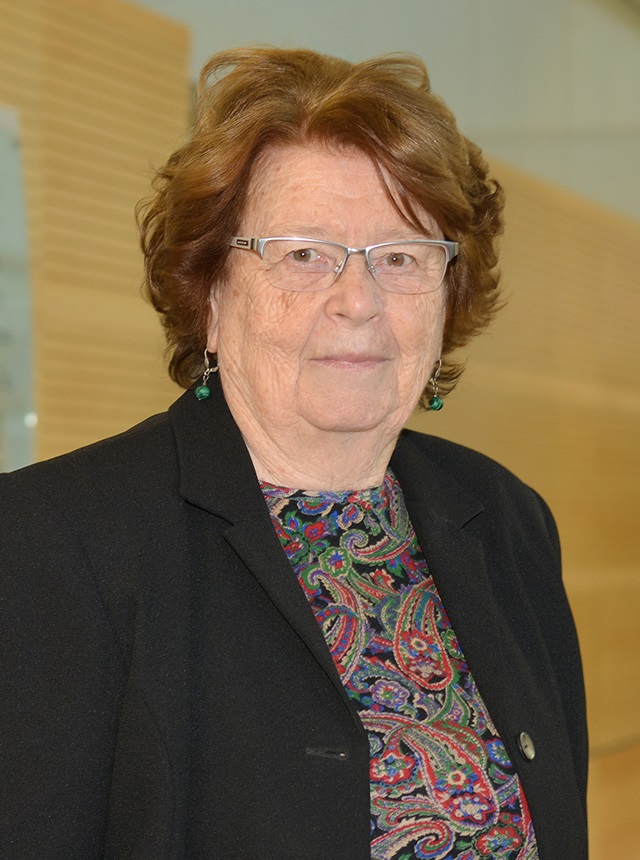
A Storied 60-Year Career at Fox Chase
Since coming to Fox Chase Cancer Center in 1956, Jenny Pickworth Glusker, DSc, has had a long and storied career in the field of x-ray crystallography, which is used to determine the structure of molecules. She helped pioneer the application of the technology to biological molecules such as DNA in order to shed light on disease, which is now a common practice in cancer research.
Glusker was born in Birmingham, England, and both her parents were doctors. Her father came from a medical family in eastern England. Her mother, Jane, came from a long line of Scottish doctors, including Sir James Wylie, who served as chief physician to three Russian czars and is mentioned in Tolstoy’s “War and Peace.”
During World War I, there was a shortage of doctors, so Jane, who was an excellent student, got sent to medical school at Glasgow University. Glusker’s father, Frederick Alfred Pickworth, was very interested in brain function and worked as a physician and researcher in a mental hospital in Birmingham.
After several years of practicing medicine and having three children, Jane stayed home to raise them. When she wanted to return to practice, the system in place in England at that time would not allow her to compete with other doctors in the area.
“She was very frustrated that she could not continue with a career that she had put so much energy into,” Glusker wrote in a memoir that she penned for the American Crystallographic Association, an organization she once served as president. “For this reason, I decided that I would find a way to continue working, even if I had children.”
She did that and much more.
She was fascinated by her parents’ medical school textbooks and eventually acquired a chemistry set that she kept under her bed. But an even more crucial influence was Yvonne Way, a chemistry teacher that Glusker had in high school. “She had a PhD, but decided that she wanted to teach rather than do research, and it was a joy to go to her classes,” Glusker said.
Glusker went on to Somerville College, one of the women’s colleges at Oxford. The person who interviewed her for admission to the program and who she would do her graduate work with was Dorothy Hodgkin. It was in Hodgkin’s lab that Glusker would learn how to determine molecular structure by X-ray diffraction, and her graduate work was part of the establishment of the chemical formula of vitamin B12.
Hodgkin would go on to win the Nobel Prize in chemistry in 1964 for confirming the structure of penicillin and determining the structure of vitamin B12. In addition to being a role model because of her scientific work, she was also a role model for Glusker because of how she balanced scientific research with the challenge of being a mother with three children.
After Oxford, Glusker spent a year as a postdoctoral fellow at Caltech in the lab of Robert Corey and Linus Pauling, who had just won the Nobel Prize in chemistry. During her time at Caltech, Glusker became friends with Dorothy Semenow, the first woman to receive a PhD from the Caltech chemistry department.
After Glusker left Caltech, she and her husband Don, a Rhodes scholar from California who was also a chemist, were applying for jobs at chemical companies in Philadelphia, and she wrote to Hodgkin for a letter of recommendation. Hodgkin replied with a letter that began, “You silly girl.” She went on to admonish Glusker to apply for a job with Lindo Patterson at the Institute for Cancer Research, one of the precursors to Fox Chase Cancer Center.
Patterson had developed what came to be known as the Patterson function, a fundamental equation in X-ray crystallography that helps determine the atomic structure and characteristics of molecules. Glusker came to the institute in 1956 after being hired by Patterson and Stanley P. Reimann, one of the founders of Fox Chase. “There were quite a lot of women that he brought along,” Glusker said of Reimann. “He went out of his way to make me feel welcome.”
During her time at Fox Chase, Glusker’s work with X-ray crystallography included the determination of the structures of numerous antitumor agents and chemical carcinogens, as well as investigating the structures and possible mechanisms of action of several biological enzymes. She has won numerous prestigious awards for her research and coauthored several widely used textbooks for instruction in crystal structure analysis.
Glusker has received many awards, most notably a life-tenured honorary fellowship at Somerville College, Oxford, England; the Fankuchen Award of the American Crystallographic Association; and the Garvan Medal of the American Chemical Society. In 2011, she was honored with the John Scott Award, which is given to individuals whose inventions have contributed in some outstanding way to the “comfort, welfare, and happiness” of mankind.